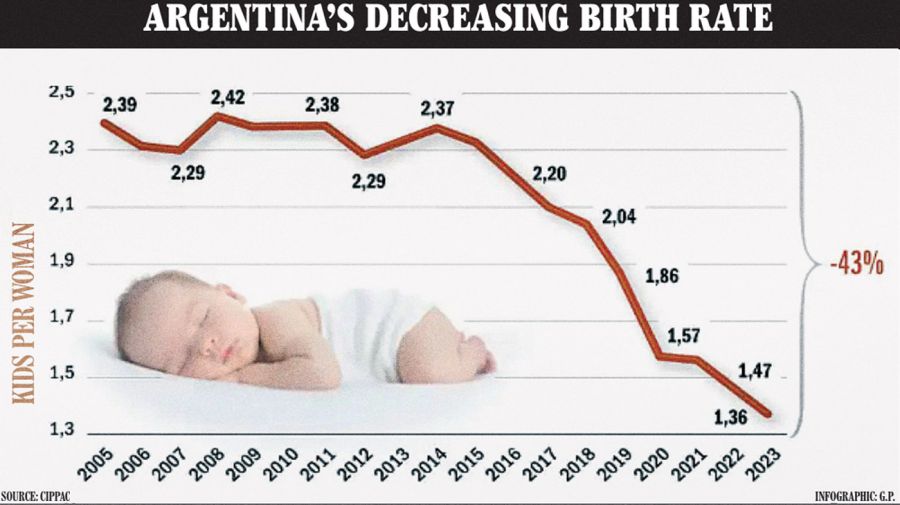A few weeks ago, Argentina’s Health Ministry published its annual summary of Argentine birth statistics in 2023. The bottom line was that a total 460,902 babies were born nationwide, confirming the downward trend of almost the last two decades – for example, the number of live births registered for 2022 was 495,295 – 6.5 percent less than in 2021 for a further slide down. From 2022 to 2023, births declined seven percent.
The demographic phenomenon is a result of various situations ,of which the main is a worldwide fall in fertility from an average of 2.42 children per mother in 2008 to the current 1.36 – a decline of 43 percent in 15 years.
To place this in historical context, at least until the French Revolution, there was an average of around seven children per mother, according to the studies of demographic historians. As from the 19th century, the number of children per woman began to drop slowly but surely throughout the developed world in a permanent trend until now. Today, the global fertility rate is low – except in the poorest countries such as Sub-Saharan Africa.
“A few days ago, the official birth data for 2023 was published. As was to be expected, they show a continued drop, around seven percent, from the 2022 numbers,” analysed demographic scholar and CIPPEC researcher Dr. Rafael Rofman in a post on social media.
However, according to the expert, there is no cause for alarm. Rather, it is a situation which must be analysed to avoid risks and take advantage of the opportunities to adapt policies and institutions to the population trend.

West and LatAm
In reality, Argentina’s current fertility figures are not extraordinary but already similar to other Western European countries and also many Latin American nations.
For Rofman, some good news can be found in the analysis of these figures. “The decline continues to be faster among adolescents (10 percent for 2023) with a cumulative decline of 66 percent when compared to the numbers of a decade ago (2014). And these tend to be almost always unwanted pregnancies which make life difficult for women who are studying or beginning to work. Avoiding them is pure gain for them and society,” he told Perfil.
Furthermore, according to the researcher, “the decline is also concentrated on women with lower levels of education.” Births in this group have fallen 67 percent since 2014 as against 28 percent for highly educated women. Still better, the fall for undereducated adolescents is over 80 percent.
The CIPPEC researcher explained why this is positive: it implies that more women will have more opportunities to be able to complete their education or find better jobs.
“In economic terms it is greater human capital for everybody and a deeper demographic bonus. Tremendous opportunities permitting us to grow faster if we take advantage of them,” he assured.
At the same time this situation consolidates another phenomenon – it implies an ageing population in the long term and, if not reversed, a shrinking population. The ageing is inevitable and is already happening. The average age in Argentina today is around 40 and will slowly rise at the rate of almost a year per decade.
“This obliges us, for example, to rethink the pension system to make it fairer and more sustainable. It’s not very complicated but requires political decisions. We’ve been talking about this issue for a long while and now it’s time to advance with consensus,” affirmed Rofman.
Growing population?
On the other hand, Dr. Rofman recalled that the latest numbers indicate that the population is growing and “will continue to do so during the next few decades,” before “beginning to dip slightly in 2050.”
“If fertility stabilises at the current levels, the country’s population will oscillate between 45 and 50 million in the next 50 years,” the expert forecast.
For those reasons there is not much sense in alarmism or talk about a possible “depopulation.”
“That would be an extremely long-term and improbable scenario if we can work to facilitate life for those who want to have children while making our workforce more productive,” Rofman said.
How? Firstly, by offering, for example, better parental leave, childcare and free quality education, among other things, Secondly, by implying the increase in human and physical capital and the use of technology.
For Rofman, the future demographic challenge for Argentina is not to increase population but productivity.
“We have to get rich before we get old and that takes a lot of improvement in terms of education, investment and adopting technology. That is the most urgent task. The current trend in fertility numbers is no risk for the countries, as some referential figures say, but a challenge which we must take advantage of by responding with the right public policies,” he said.
“It should be recalled that the fall in the birth rate is a global phenomenon, as reflected by the CEPAL (United Nations Commission for Latin America and the Caribbean) data,” said Dolores Dimier De Vicente, Universidad Austral professor and researcher. “Two countries in particular in Latin America now head this trend with the lowest birth rates: Chile and Argentina.”
Dr Lorena Bolsón, dean of the Family Institute at the Universidad Austral, highlighted one detail in particular: “In both countries it is still something recent which accelerated a lot more during the past decade without this demographic phenomenon having been forecast.”
How is that explained? The expert assured that “this is somewhere where we have to go into more depth, especially if we want to establish state policies to compensate or cushion these trends. We have some possible hypotheses but without more specific research we cannot be sure of the causes.”
Among the causes are greater access to various options for birth control and increased education without neglecting to mention limitations on the availability of the funding necessary to accompany this experience, to which should be added a deficient context of monetary stability and uncertainty as to the environmental, social, etc future.
Finally, experts consulted cited greater difficulties for couples when establishing lasting relationships with males, including acceptance of lifelong paternity.
Commitment
The phenomenon of opting for fewer children is also reinforced by another characteristic: the age of maternity with increasingly more women choosing to become mothers later in life. This factor, linked to biological reasons, also adds up to less children per mother.
One important point: according to the researchers, there is no data that indicates that the recent legalisation of abortion in Argentina is a factor which can be directly linked to this lower natality, despite the claims of critics of the policy.
Both researchers dare to think of the future: “All the projections indicate that from here to 2050, we will continue seeing this trend to lower birth rates consolidated” while agreeing with Rofman that advantage should be taken of the current “demographic bonus” being experienced by our society.
“But,” they affirm, “in Argentina today we are still not prepared to deal with the ageing society which seems on the way – so if we don’t do it right, that bonus could become a demographic debt.”
Among the things they propose is understanding a society facing changes and challenges. For example, in this transition more vacancies will be seen in schools, opening up the possibility of a better education with the current number of teachers. But preparations will also be needed in other areas: pensions, medicine, etc, to be able to give contention, quality of life and independence to the newly aged. In other words, contemplating the public policies to attend to the requirements of an “ageing” society.





















Comments